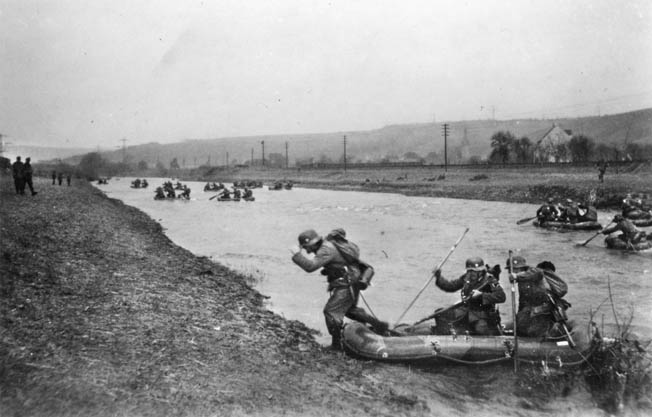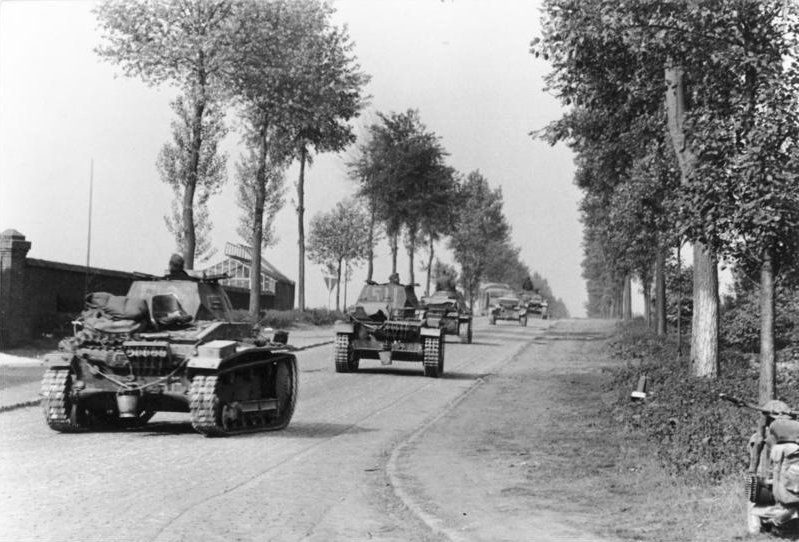May 10th - May 21st, 1940
Western Front
On May 10th, as the invasion of the Low Countries started, the eyes had shifted from the Maginot line to the north. At the same time as the Netherlands and Belgium, Luxembourg was invaded. Already on alert thanks to the Belgian warnings, the Luxembourgian army and gendarmes put up a stiff resistance along the Schuster line.
Unfortunately, with less than 700 personnel, these efforts were doomed to fail. By the end of the day, the surviving Luxembourgian forces had retreated towards Longwy and the first casemates of the Maginot Line, which extended up until La Ferté. After that, it was the Belgian border, starting with…Sedan.
For the French high command, though, this was not really a problem. Marshal Pétain had described the Ardennes as « impenetrable » while Gamelin considered them the “best anti-tank obstacle in the world”. In all, the French command estimated that a breakthrough here would take the Germans two weeks to achieve.
This was an opinion that was not shared by all in the high command. General Prételat, for example, had conducted military exercises in 1938 that showed that the Meuse could be crossed in less than 60 hours, and with only a handful of divisions. His warnings were not heard [1].
As a result of this overconfidence, Sedan was only defended by one infantry division (the 55th), reinforced by another (the 71st) once the assault was underway. On the other side, the German high command had identified Sedan as the weak point of the French defense, and put three Panzer Divisions at Von Rundstedt’s disposal to break through and swoop in towards the sea.
But before Sedan, the Germans had to battle their way through Belgium. And there, the Belgian forces, on alert, gave them a big fight. The elite Chasseurs Ardennais, the “Green Devils”, as Rommel would nickname them, held firm at Bohange, protecting the road to Bastogne. The Germans would be delayed for two days as the Chasseurs organized controlled retreats and ambushes, before withdrawing in fear of a flanking manoeuvre from the north.
This resistance allowed the deployment of the 71st Infantry to Sedan, though this one was still incomplete by the evening of May 13th, when the 1st, 2nd and 10th Panzer Divisions arrived in front of the French city.
On the morning of May 14th, the Luftwaffe sortied
en masse against Sedan, with Ju 87 bombers striking hard on the French positions in the city. The Armée de l’Air was unfortunately powerless to stop this, being occupied in Belgium, as orders dictated that the effort of the Allied air forces should be directed towards Belgium, not France.
In the evening, a report by a French artilleryman was passed on stating that German tanks were at Bulson, to the south. Quickly corrected, this error did sow some confusion amidst the ranks of the 55th Division, who had started packing their bags to get the hell out of Sedan before being encircled, thus leaving the south bank undefended [2].
Therefore, when the German tanks hit, it was against a severely rattled 55th Division, but one that was still entrenched in the city. Quickly, the French artillery in Charleville-Mézieres pounded the attackers in response, inflicting heavy casualties amongst the ranks of the GroBdeutschland regiment, sent in support of the Panzers. This regiment was tasked with clearing out the bunkers of the city, a task that they unfortunately could not be carried out.
The Panzer divisions did not have much luck in their strikes against Donchéry and Wadelincourt, either. With the support of the 71st Infantry and the rolling barrage of artillery, the Panzers were pinned on the northern bank of the Meuse.
It wouldn’t be until the first light of day on the 15th that the Panzers would start establishing bridgeheads, while fighting raged on in the city of Sedan. The 2nd Panzer having started to break through on the left, at Donchéry, and fearing an advance towards Cheveuges, Charles Huntziger, commander of the French forces in the sector, ordered to evacuate the North bank of the Meuse entirely.
All day on the 15th, the RAF and Armée de l’Air flew sorties to try and contain the 2nd Panzer’s breach to the west, and stop the other divisions from establishing bridgeheads. But the Luftwaffe was there to make the Allies pay a steep price for each sortie. In total, more than 30 Allied aircraft were shot down by the Luftwaffe or the anti-air batteries on the ground, likely saving the 2nd Panzer’s bridgehead at Donchéry, and allowing the 10th Panzer to establish its own bridgehead at Wadelincourt.
On the 16th, Huntziger ordered to evacuate Sedan itself, fearing a pincer maneuver of the 10th Panzer that would cut off a third of the 55th Infantry’s troops in the city. By noon, the Nazi flag was flying on the town hall, and the Germans had taken the southern bank.
But the French were not going to let themselves be run over. In fact, the French had brought their own armor, XXI Corps under General Flavigny, to counter it: 300 tanks including more than a hundred B1bis, behemoths of steel which could match anything the Germans had.
Under the blows of the artillery, the Germans had lost more than fifteen hours crossing the Meuse, owing to Colonel Poncelet’s determination in holding the bridges under fire [3]. However, Flavigny waited and waited. Having received reports of Germans crossing the Meuse in force, he wished confirmation before moving his tanks into a potential pocket. By the time he had finally moved forward, the Germans had indeed crossed. Had Flavigny attacked immediately, the Germans would still have been in the process of crossing the Meuse [4].
Luckily for Flavigny, he could still reach Bulson before the Germans, owing to the staunch French defence in the ruins of Sedan. The Germans of the 1st Panzer, confident after crossing the Meuse, immediately ran into Flavigny’s tanks as they rushed from Thelonne to Bulson. With horror, Kirchner, commanding the 1st Panzer, noticed that his PaK 36 anti-tank guns bounced off the armor of the B1bis, which wreaked havoc in the ranks of the Panzer, which only had their speed to counter them.
And that was not counting on the French artillery, which struck the Germans in the woods. In one occasion, the 1st Panzer Regiment was completely wiped out, with just a single tank surviving the encounter [5].
Lacking heavy artillery, the Germans were stuck in the village until May 17th, when the heavy artillery of the GroBdeutschland could finally answer the French one, pushing the French out of Bulson. Though this would also be a blessing for the Germans: the delay had allowed the infantry divisions to catch up, and support the tanks.
On May 18th, the Germans had regained some advantage, while the French were still lacking to reinforce the Sedan bridgehead. As such, Guderian immediately sent his tanks of the 1st and 2nd Panzer forwards, into the undefended French rear and towards the sea, using the infantry to plug the gap. Meanwhile, he kept the 10th Panzer and GroBdeutschland at Sedan to feint an encirclement of the Maginot Line.
It was only on May 19th that the French had managed to amass enough forces to strike at Guderian. That day, the small village of Stonne had become the site of heavy fighting, with the forces of the 10th Panzer receiving a complete thrashing. For two full days, the village of Stonne changed hands no less than seventeen times, with the French B1bis tanks running hogwild.
In a particular instance, the B1bis of future minister Pierre Billotte, ran into the village, destroyed no less than 13 tanks (2 Pz IV, 11 Pz III) and ran back to its lines, having counted 140 hits in its armor, with not a single hit piercing [6].
But the slow speed of the B1bis stopped any attempt at actually exploiting this victory. On May 21st, the Germans of the 10th Panzer, defeated but not broken, managed to reform their line at Chémery and Maisoncelle, stopping the French counter-offensive in its tracks. The timely arrival of the 16th and 24th Infantry Divisions stopped the French attempts at a further counter-attack, which would prove more costly.
However, if Sedan could be considered a victory for the Germans, it came at a cost. The 10th Panzer was knocked out of combat, and it would take a few weeks for it to recover. The GroBdeutschland Regiment had taken horrific casualties, and the 1st and 2nd Panzer Divisions had also taken high losses. With more than 10,000 German dead or wounded, the time was now for exploitation. Guderian had gambled a lot on Sedan, he would now have to exploit his costly victory.
On the evening of the 21st, German tanks had reached Hirson and Montcornet. That same day, General Gamelin was removed of his command and replaced by General Weygand.
[1] Yes, Prételat actually did these excercises in OTL and actually told the French high command that the Ardennes were not an obstacle for tanks. Yet another reason why Gamelin deserved much worse than what he got.
[2] In OTL, these positions were deserted and the heavy equipment abandoned.
[3] In OTL, Poncelet had ordered a retreat during the Bulson false alarm. In shame, he shot himself a few days later.
[4] This is OTL. Flavigny actually had a chance to beat back the Germans but, too cautious, did not want to risk his units due to a miscommunication.
[5] Exactly like OTL. The German PanzerDivisions got bled dry at Sedan, too bad it was too late to prevent the breakthrough.
[6] This anecdote is OTL. Stonne was a complete disaster for the Germans.


